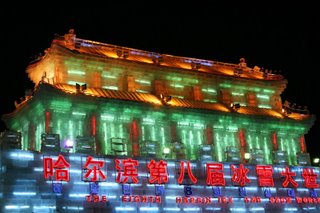 The annual Harbin International Ice and Snow Sculpture Festival have been held since 1963. It had been interrupted for a number of years during the Cultural Revolution until it was resumed in 1985.
The annual Harbin International Ice and Snow Sculpture Festival have been held since 1963. It had been interrupted for a number of years during the Cultural Revolution until it was resumed in 1985.Harbin, the capital of Heilongjiang province of People's Republic of China, is one of the sources of ice and snow culture in the world. Geographically, it is located in Northeast China under the direct influence of the cold winter wind from Siberia. The average temperature in summer is 21.2 degrees Celsius, -16.8 degrees Celsius in winter. It can be as cold as - 38.1 degrees Celsius in winter. Officially, the festival starts from January 5th and it lasts one month. However often the exhibitions open earlier and last longer, weather permitting. Ice sculpture decoration ranges from the modern technology of lasers to traditional ice lanterns. There are ice lantern park touring activities held in many parks in the city. Winter activities in the festival include Yabuli alpine skiing, winter-swimming in Songhua River, and the ice-lantern exhibition in Zhaolin Garden. Snow carving and ice and snow recreations are world famous.
The Harbin festival is one of the world's four largest ice and snow festivals, along with Japan's Sapporo Snow Festival, Canada's Quebec City Winter Carnival, and Norway's Ski Festival.The 2007 festival featured the Canadian theme, memoria in m of Canadian doctor Norman Bethune. It also a Guinness Record of the largest snow sculpture: 250 meters long, 28 feet (8.5 m) high, using over 13,000 cubic meters of snow. The composition consisted of two parts: "Niagara Falls" and "Crossing the Bering Strait" (the latter depicting the migration of the First Nations).
Zhaolin Park is a 'must see' during the Harbin Ice Festival because it has a traditional program that shows the most excellent ice lanterns. With water, lights and the natural ice from the Songhua River running through Harbin as the material, the ice lanterns are made by freezing water, piling up ice or snow, then carving, enchasing, decorating, etc. The ice lantern park touring activities have been held here annually since 1963 and is said to be one of the most wonderful 35 tourist attractions in China. There are numerous pieces of ice artworks in the park arranged in groups according to different themes depicting Chinese classic masterworks, European folktales and customs and so on. A great variety of objects such as buildings, gardens, flowers, waterfalls, European-styled churches, lions, tigers, dragons are carved from ice. In the daytime, the ice sculptures are magnificent and verisimilitude. Moreover, with the interspersion of the sparkling colored lights embedded in the sculptures at night, the park becomes a glorious and amazing ice world.
Today, Harbin Ice Festival is not only an exposition of ice and snow art, but also an annual cultural event for international exchange. Every year, there are many ice sculpture experts, artists and fans from America, Canada, Japan, Singapore, Russia, China, etc. gathering in Harbin to participate ice sculpting competitions and to communicate with each other in the ice and snow world. Also, Harbin ice lanterns have been exhibited in most of China's main cities as well as in many countries in Asia, Europe, North America, Africa and Oceania. For more than 40 years, Harbin's natural resource of ice and snow has been fully explored to provide joy and fun for visitors to the city. Now during the festival, many sporting competitions are also popular including ice-skating, sledding and so on. Weddings, parties and other entertainments are now very much a feature of this ice world, adding their own contribution to the celebrations of this great festival of art, culture, sports and tourism.